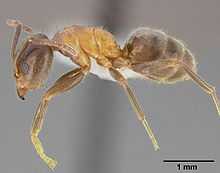Liometopum
| Liometopum | |
|---|---|
 | |
| Liometopum occidentale worker | |
| Scientific classification | |
| Kingdom: | Animalia |
| Phylum: | Arthropoda |
| Class: | Insecta |
| Order: | Hymenoptera |
| Family: | Formicidae |
| Subfamily: | Dolichoderinae |
| Tribe: | Tapinomini |
| Genus: | Liometopum Mayr, 1861 |
| Type species | |
| Formica microcephala Panzer, 1798 | |
| Diversity[1] | |
| 26 species | |
| Synonyms | |
|
†Poneropsis Heer, 1867 | |
Liometopum is a genus of ants that belongs to the subfamily Dolichoderinae.[2] The genus is regionally distributed across North America, Europe and Asia.[3]
In Mexico, colonies of Liometopum have been used as a food resource by people in rural areas for centuries. The immature stages of the reproductive caste, known as "escamoles" are consumed and are a high-quality source of protein, carbohydrates, and lipids. Adult reproductives may also be consumed by humans during swarming, and worker brood is consumed when other stages are scarce.[4]
Caterpillars of certain butterfly species have a symbiotic relationship with Liometopum ants. They produce secretions that the ants will feed on, similar to the Iridomyrmex genus of ants.
Species
- Liometopum apiculatum Mayr, 1870
- †Liometopum bogdassarovi (Nazaraw, Bagdasaraw & Uriew, 1994)
- †Liometopum brunascens (Heer, 1867)
- †Liometopum crassinervis Heer, 1849
- †Liometopum croaticum (Heer, 1849)
- †Liometopum eremicum Zhang, 1989
- †Liometopum escheri (Heer, 1867)
- †Liometopum globosum (Heer, 1849)
- †Liometopum imhoffii (Heer, 1849)
- Liometopum lindgreeni Forel, 1902
- †Liometopum longaevum (Heer, 1849)
- †Liometopum lubricum Zhang, Sun & Zhang, 1994
- Liometopum luctuosum Wheeler, 1905 – the pine tree ant
- Liometopum microcephalum (Panzer, 1798)
- †Liometopum miocenicum Carpenter, 1930
- Liometopum occidentale Emery, 1895 – the velvety tree ant
- †Liometopum oligocenicum Wheeler, 1915
- Liometopum orientale Karavaiev, 1927
- †Liometopum pallidum (Heer, 1867)
- †Liometopum potamophilum Zhang, 1989
- †Liometopum rhenana (Meunier, 1917)
- †Liometopum scudderi Carpenter, 1930
- Liometopum sinense Wheeler, 1921
- †Liometopum stygium (Heer, 1867)
- †Liometopum venerarium (Heer, 1864)
- †Liometopum ventrosum (Heer, 1849)
References
- ↑ Bolton, B. (2014). "Liometopum". AntCat. Retrieved 5 July 2014.
- ↑ "Genus: Liometopum". antweb.org. AntWeb. Retrieved 2 October 2013.
- ↑ Hoey-Chamberlain, Rust & Klotz 2013, p. 1
- ↑ Hoey-Chamberlain, Rust & Klotz 2013, p. 2
- Hoey-Chamberlain, R; Rust, MK; Klotz, JH (2013), "A Review of the Biology, Ecology and Behavior of Velvety Tree Ants of North America", Sociobiology 60 (1): 1–10, doi:10.13102/sociobiology.v60i1.1-10
 This article incorporates text from a scholarly publication published under a copyright license that allows anyone to reuse, revise, remix and redistribute the materials in any form for any purpose: Hoey-Chamberlain, R; Rust, MK; Klotz, JH (2013), "A Review of the Biology, Ecology and Behavior of Velvety Tree Ants of North America", Sociobiology 60 (1): 1–10, doi:10.13102/sociobiology.v60i1.1-10 Please check the source for the exact licensing terms.
This article incorporates text from a scholarly publication published under a copyright license that allows anyone to reuse, revise, remix and redistribute the materials in any form for any purpose: Hoey-Chamberlain, R; Rust, MK; Klotz, JH (2013), "A Review of the Biology, Ecology and Behavior of Velvety Tree Ants of North America", Sociobiology 60 (1): 1–10, doi:10.13102/sociobiology.v60i1.1-10 Please check the source for the exact licensing terms.
External links
 Media related to Liometopum at Wikimedia Commons
Media related to Liometopum at Wikimedia Commons Data related to Liometopum at Wikispecies
Data related to Liometopum at Wikispecies